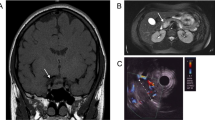Abstract
Multiple endocrine neoplasia type 1 (MEN1) is a syndrome inherited in an autosomal dominant trait caused by the inactivation of the tumor suppressor gene MEN1. Objective: To communicate a family with a new heterozygous germ line mutation in the intronic region of MEN1 gene and to study its influence in the menin expression. Patients and Methods: We studied 5 members of a family with symptomatic hyperparathyroidism (HPT). One of them had also a neuroendocrine pancreatic tumor, and 2 had non-functional multinodular cortical adrenal hyperplasia compatible with the diagnosis of MEN1. After the mutation was identified, HSP92II restriction enzyme was used to determine both zygosity and segregation of the mutation. RT-PCR from leukocyte’s isolated mRNA and western blot from pancreatic tumor tissue were performed. In vitro studies were done in Chinese hamster ovary (CHO) cells transfected with reporter minigenes carrying the coding regions spanning exon (EX)-intron 9 and EX10 with the mutant and the wild type sequences. Results: We identified a heterozygous G-to-T substitution in the intron-EX junction (IVS9-1 G>T) of MEN1 gene in the index case and the family members. The mRNA from patient’s leukocytes was larger (934 bp) in comparison to the normal transcript (717 bp). Immunoblot analysis demonstrated that wild type (67 kDa) and two additional mutant proteins (~55 and ~90 kDa) were expressed in the pancreatic tissue. The in vitro study showed a 45% nuclear localization of the mutated menin signal and a 95% in the wild type protein. Conclusions: We identified a new intronic heterozygous germ line mutation (IVS9-1G>T) of MEN1 gene in a family affected by MEN1 syndrome. This mutation alters the splice acceptor site of intron 9 that promotes an incorrect splicing, generating aberrant proteins without the nuclear localization signals necessary for the normal menin translocation to the nucleus.
Similar content being viewed by others
References
Brandi ML, Gagel RF, Angeli A, et al. Guidelines for diagnosis and therapy of MEN type 1 and type 2. J Clin Endocrinol Metab 2001, 86: 5658–71.
Guo S, Sawicki M. Molecular and genetic mechanisms of tumorigenesis in multiple endocrine neoplasia type-1. Mol Endocrinol 2000, 15: 1653–64.
Yaguchi H, Ohkura N, Takahashi M, Nagamura Y, Kitabayashi I, Tsukada T. Menin missense mutants associated with multiple endocrine neoplasia type 1 are rapidly degraded via the ubiquitin-proteasome pathway. Mol Cell Biol 2004, 15: 6569–80.
Chandrasekharappa SC, Guru SC, Manickam P, et al. Positional cloning of the gene for multiple endocrine neoplasia type 1. Science 1997, 276: 404–7.
Agarwal SK, Guru SC, Heppner C, et al. Menin interacts with the AP1 transcription factor Jun D and represses JunD-activated transcription. Cell 1999, 96: 143–52.
Weitzman JB, Fiette L, Matsuo K, Yaniv M. JunD protects cells from p53-dependent senescence and apoptosis. Mol Cell 2000, 6: 1109–19.
Chandrasekharappa SC, Teh BT. Functional studies of the MEN1 gene. J Intern Med 2003, 253: 606–15.
Vieira JG, Tachibana TT, Obara LH, Maciel RB. Extensive experience and validation of polyethylene glycol (PEG) precipitation as screening method for macroprolactinemia. Clin Chem 1998, 44: 1758–9.
Carrasco C, Gonzalez A, Carvajal C, et al. Novel intronic mutation of MEN1 gene causing familial isolated primary hyperparathyroidism. J Clin Endocrinol Metab 2004, 89: 4124–9.
Marx SJ. Molecular genetics of multiple endocrine neoplasia types 1 and 2. Nat Rev Cancer 2005, 5: 367–75.
Hou SH, Grossman S, Molitch ME. Hyperprolactinemia in patients with renal insufficiency and chronic renal failure requiring hemodialysis or chronic ambulatory peritoneal dialysis. Am J Kidney Dis 1985, 6: 245–49.
Iglesias P, Diez JJ, Fernandez-Reyes MJ, et al. Growth hormone, IGF-I and its binding proteins (IGFBP-1 and -3) in adult uraemic patients undergoing peritoneal dialysis and haemodialysis. Clin Endocrinol (Oxf) 2004, 60: 741–9.
Bonetti B, Fu L, Moon J, Bedwell DM. The efficiency of translation termination is determined by a synergistic interplay between upstream and downstream sequences in Saccharomyces cerevisiae. J Mol Biol 1995, 251: 334–45.
Bale AE, Norton JA, Wong EL. Allelic loss on chromosome 11 in hereditary and sporadic tumors related to familial multiple endocrine neoplasia type 1. Cancer Res 1991, 51: 1154–7.
Bystrom C, Larsson C, Blomberg C. Localization of the MEN1 gene to a small region within chromosome 11q13 by deletion mapping in tumors. Proc Natl Acad Sci USA 1990, 87: 1968–72.
Radford DM, Ashley SW, Wells Jr SA, Gerhard DS. Loss of heterozygosity of markers on chromosome 11 in tumors from patients with multiple endocrine neoplasia syndrome type 1. Cancer Res 1990, 50: 6529–33.
Sawicki MP, Wan YJ, Johnson CL, Berenson J, Gatti R, Passaro Jr E. Loss of heterozygosity on chromosome 11 in sporadic gastrinomas. Hum Genet 1992, 89: 445–9.
Friedman E, De Marco L, Gejman PV. Allelic loss from chromosome 11 in parathyroid tumors. Cancer Res 1992 52: 6804–9.
Debelenko LV, Zhuang Z, Emmert-Buck MR. Allelic deletions on chromosome 11q13 in multiple endocrine neoplasia type 1 -associated and sporadic gastrinomas and pancreatic endocrine tumors. Cancer Res 1997, 57: 2238–43.
Lubensky IA, Debelenko LV, Zhuang Z, et al. Allelic deletions on chromosome 11q13 in multiple tumors from individual MEN1 patients. Cancer Res 1996, 56: 5272–8.
Eubanks PJ, Sawicki MP, Samara GJ. Pancreatic endocrine tumors with loss of heterozygosity at the multiple endocrine neoplasia type I locus. Am J Surg 1997, 173: 51 8–20.
Ikeo Y, Sakurai A, Hashizume K. Characterization of the MEN1 gene produce, menin, by site-specific polyclonal antibodies. Jpn J Cancer Res 1999, 90: 1088–95.
Wautot V, Vercherat C, Lespinasse J, et al. Germline mutation profile of MEN1 in multiple endocrine neoplasia type 1: search for correlation between phenotype and the functional domains of the MEN1 protein. Human Mutation 2002, 20: 35–47.
Author information
Authors and Affiliations
Corresponding author
Rights and permissions
About this article
Cite this article
Tala, H.P., Carvajal, C.A., González, A.A. et al. New splicing mutation of MEN1 gene affecting the translocation of menin to the nucleous. J Endocrinol Invest 29, 888–893 (2006). https://doi.org/10.1007/BF03349192
Accepted:
Published:
Issue Date:
DOI: https://doi.org/10.1007/BF03349192




